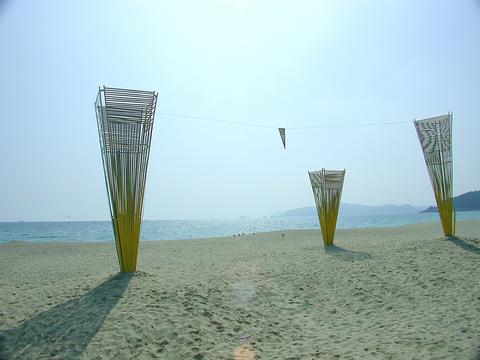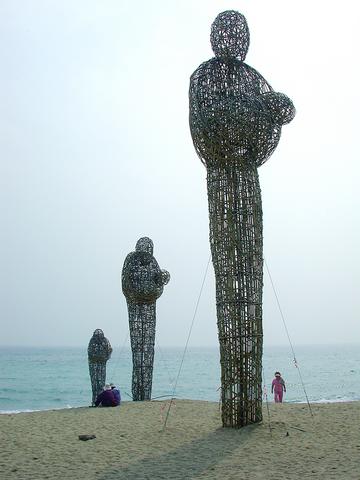Taiwan's contributions to the Busan Biennale in South Korea are either tucked away in a distant corner or illuminate one of the main gallery spaces, which was likely unintended but nevertheless seems appropriate.
Striving for exposure but not ignored, Taiwan's artists do not have to exhibit under the guise "Chinese Taipei" -- as do Taiwan's athletes playing in the concurrent Asian Games -- but their collective voice is barely heard in the international arts sphere.
Though South Korea's circumstances are different from those of Tawan, it is reasonable to presume that if it hosted genuinely international art exhibitions, or sports competitions like the Asian Games, then Taiwan's voice might be heard a little louder.

PHOTOS: JULES QUARTLY, TAIPEI TIMES
"Culture meets culture" is the theme of the collection of international art that has been gathered in Busan. It comprises a contemporary exhibition, a sea art festival, a sculpture project and various "guerilla artfare" performances that occur throughout the city at various times.
"Artists were chosen from various countries because the curators thought their work represented urbanity and the city is where cultures meet and coexist," said one of the Biennale's coordinators Kwon Ki-hyun.
"They were commissioned to produce a work of art for us and we encouraged them to come to Busan so it could be about our city. As a result, we now have a volume of art that is dedicated to it."

Other works, Kwon said, were borrowed from collections because they were thought to represent a particular notion of metropolis that was universal to all cities.
Taiwanese artist Yuan Guang-ming's contribution is in this category. Placed in a hard-to-find recess of the Busan Metropolitan Art Museum, the his looped black and white film pans very slowly across an empty street corner of Hsimenting, Taipei. The rhetorical question the artist poses is, "If all the movements in the crowded city are removed, what can one expect?"
It does not take a genius to present this: Shades of concrete gray enlivened only by the white markings of a zebra crossing and detritus. Some people looked in, stared, waited for something to happen and left.
More lively and inspiring were the works of artists, such as South Korea's Jung Yeon-doo, who recreates a dancehall within the museum, complete with blinking lights and snapshots of couples dancing on the walls. His aim is to renew one's perception of cabaret culture.
Taiwan's Hung Tung-lu looks at the city through comic book and computer game lenses. His saturated holographic images of X-men or women in fighting stances pose in front of traditional Chinese monuments, surrounded by dense fields of chocolate box-like flowers. Asura, or "state of frenzy," appears to depict an attack by spacecraft on a US city that looks like New York. Finished before 911, Hung's take is that "images get ahead of reality."
Whatever. The best part of the Biennale is that it gets out of the museum, onto the street -- and in this case, the beach -- and away from the artists' explanations of their own works or the critics' interpretations.
There is pleasure rather than debate in seeing giant statues of split and tied cane men rising out of the sands and toward the sea on Haeundae Beach, such as Choi Pyung-gon's For a Baby. Frankly, the artist's claim that these figures represent young children in an Afghanistan refugee camp are ludicrous.
A collective of Busan artists has built a stretch Cadillac with sails and anyone can climb into the driver's seat and imagine driving across the ocean. The Spirit of Pioneers, by another South Korean group, is a full-size train rising out of the sand and over the sea.
Children wonder at these images, tourists are impressed and at night, lovers take a bottle of soju stroll around to enjoy these unusual and sometimes inspiring sights.

April 14 to April 20 In March 1947, Sising Katadrepan urged the government to drop the “high mountain people” (高山族) designation for Indigenous Taiwanese and refer to them as “Taiwan people” (台灣族). He considered the term derogatory, arguing that it made them sound like animals. The Taiwan Provincial Government agreed to stop using the term, stating that Indigenous Taiwanese suffered all sorts of discrimination and oppression under the Japanese and were forced to live in the mountains as outsiders to society. Now, under the new regime, they would be seen as equals, thus they should be henceforth

Last week, the the National Immigration Agency (NIA) told the legislature that more than 10,000 naturalized Taiwanese citizens from the People’s Republic of China (PRC) risked having their citizenship revoked if they failed to provide proof that they had renounced their Chinese household registration within the next three months. Renunciation is required under the Act Governing Relations Between the People of the Taiwan Area and the Mainland Area (臺灣地區與大陸地區人民關係條例), as amended in 2004, though it was only a legal requirement after 2000. Prior to that, it had been only an administrative requirement since the Nationality Act (國籍法) was established in

With over 80 works on display, this is Louise Bourgeois’ first solo show in Taiwan. Visitors are invited to traverse her world of love and hate, vengeance and acceptance, trauma and reconciliation. Dominating the entrance, the nine-foot-tall Crouching Spider (2003) greets visitors. The creature looms behind the glass facade, symbolic protector and gatekeeper to the intimate journey ahead. Bourgeois, best known for her giant spider sculptures, is one of the most influential artist of the twentieth century. Blending vulnerability and defiance through themes of sexuality, trauma and identity, her work reshaped the landscape of contemporary art with fearless honesty. “People are influenced by

The remains of this Japanese-era trail designed to protect the camphor industry make for a scenic day-hike, a fascinating overnight hike or a challenging multi-day adventure Maolin District (茂林) in Kaohsiung is well known for beautiful roadside scenery, waterfalls, the annual butterfly migration and indigenous culture. A lesser known but worthwhile destination here lies along the very top of the valley: the Liugui Security Path (六龜警備道). This relic of the Japanese era once isolated the Maolin valley from the outside world but now serves to draw tourists in. The path originally ran for about 50km, but not all of this trail is still easily walkable. The nicest section for a simple day hike is the heavily trafficked southern section above Maolin and Wanshan (萬山) villages. Remains of